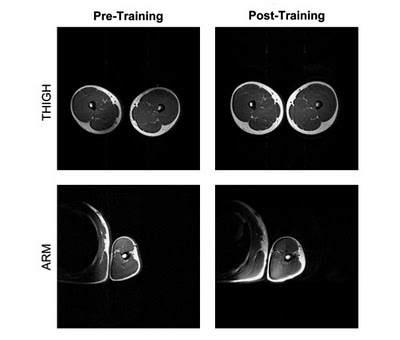Actually, yes, you can.
 The amount of time one rests between sets is an often missed, or often underestimated training variable. It’s also one of the least studied variables when it comes to looking at hypertrophy as the outcome (as opposed to strength, or other performance variables, or even biochemical markers). So it is a treat to see a study where hypertrophy is the variable of interest, and where measurement of hypertrophy is truly a direct measurement. While not every investigator can measure hypertrophy in this way, it does go to show that “It can’t be done,” or “It will never get done,” are just words, because these researchers, in the words of the famous Dos Remedios, “did work.”
The amount of time one rests between sets is an often missed, or often underestimated training variable. It’s also one of the least studied variables when it comes to looking at hypertrophy as the outcome (as opposed to strength, or other performance variables, or even biochemical markers). So it is a treat to see a study where hypertrophy is the variable of interest, and where measurement of hypertrophy is truly a direct measurement. While not every investigator can measure hypertrophy in this way, it does go to show that “It can’t be done,” or “It will never get done,” are just words, because these researchers, in the words of the famous Dos Remedios, “did work.”
de Souza TP, Fleck SJ, Simao R, et al. Comparison between constant and decreasing rest intervals: Influence on maximal strength and hypertrophy. Journal of Strength and Conditioning Research 24(7) 1843-1850, 2010.
Introduction
We know that the less you rest between sets, the less work you’re able to do in subsequent sets. Chances are, you’re not able to lift as much weight for the same number of repetitions, or you’re not able to do as many repetitions for the same amount of weight. There seem to be pros and cons to long-rest and short-rest approaches to weight training though. With long periods of rest between sets, the theory is that you’re able to better train to increase your maximal strength. However, there is some evidence to show that short periods of rest (30-40 seconds) may have metabolic and/or hormonal responses to weight training that don’t exist in long-rest approaches, which might make short-rest workouts more amenable to hypertrophy, not to mention that workouts could be made to be shorter.
A mixed approach to the problem has been proposed, whereby rest intervals are decreased over time within a training cycle. An example of this would be: 2 minutes of rest between sets in week 1, 100 seconds of rest in week 2, etc. While it’s certain that work performed (which can be crudely measured by multiplying the number of reps by the weight moved) per set is going to go down, the hypothesis these authors wanted to test was whether the hormonal changes associated with short-rest training would counter the “deficiency” of not being able to maintain the same workload from set to set.
But that’s not even the best part of this study.
Methods
The subjects in this study were young, recreationally trained men. All subjects had been lifting weights for at least one year before this study and trained at least 3 times a week.
The subjects underwent 1RM testing for squat and bench (different lifts on different days) and testing familiarization over 2 weeks before the study. Seventy-two hours after the first testing session, all subjects had the cross sectional area of their right thigh and right arm measured by MRI. Peak isometric torques were also measured for knee extension and flexion, but I’m not going to talk about these results in this review.
The subjects were then randomly assigned to do an 8-week lifting program in which the rest period was either constant (2 minutes between sets for 8 weeks) or decreasing (2 minutes between sets in week 1-2, and then decreasing every week to end up at 30 seconds between sets in week 8)
The program was 6 workouts a week, alternating between a workout A and B, Monday to Saturday. Both groups had the same exercises. In weeks 1 and 2, both groups resting for 2 minutes between sets. From week 3 onwards, the decreasing rest group got less and less rest between sets each week.
[This study, though claiming to be randomized did not report any of the standard elements that should be included in a randomized controlled trial (who was blinded, how subjects were randomly allocated, etc). However, this is actually less important as we will see in the results section.]
Results
I think it’s important to pay attention to the characteristics of subjects in a study as it has direct implications as to whether this research might apply to any particular consumer. There were 20 subjects in this study (10 in each group). The subjects in this study group were, on average, in their 20’s, somewhere around 5’10” tall and 160lbs. What does this tell us? Well, for one, in terms of a study about hypertrophy, we know that it’s likely that of all the guys that could have been in this study, these guys were in the demographic of men most likely to build muscle. So, from a sample selection point of view, this is a trial designed to succeed (which isn’t some underhanded thing, since ALL trials should be designed to succeed).
Looking at training volume (defined as weight lifted x reps lifted), the constant rest group almost always did more volume than the decreasing rest group, particularly in week 5 and onwards. Week 5 is also the point in which the decreasing rest group was approaching 1 minute of rest between sets, so it’s no surprise that their volumes started to drop off more noticeably.
Looking at maximal strength, both groups improved their bench and squat substantially over 8 weeks, but both groups improved about the same amount, so there were no differences in maximal strength detected between the two rest schemes.
Looking at hypertrophy as measured by MRI scanned cross-sectional areas of muscle in the arm and thigh, both groups improved their cross-sectional areas over 8 weeks–about 9 cm squared in the arm and about 25 cm squared in the thigh (as averages). However, the spread of values (or variance) was very high, so it’s hard to tell how important these numbers are. Ideally, the authors would have published an average CHANGE in cross-sectional area which would have been more useful for interpretation. If we make the VERY crude assumption that the cross sectional area of the muscles in the arm is a circle, that’s an improvement of about 2 cm in diameter on average.

However, both rest groups improved their cross-sectional areas about the same amount, so again, no differences beyond those we would expect to see by chance alone were detected between the two rest schemes.
Discussion
The immediate criticism of this study that likely comes to most people’s minds is, “There’s only 20 subjects in this study!”
However, this is one of those studies in which I think the question is still answered despite all of its shortcomings and reporting deficiencies. And here’s why:
1) If either rest strategy was better than the other, the population in this study was probably the most likely one in which we would have seen clear superiority. These subjects would likely have been past the initial ‘neural adaptation’ phase of training, most prone to hypertrophy given their age and proximity to ‘juvenile growth phase’ and were also likely not close to their growth potential. If we were going to see a clear advantage, any other study sample would have had less of a chance of demonstrating it.
2) While this study was underpowered, the differences in cross-sectional area between the two groups was minuscule (2cm squared in the arm and 4cm squared in the thigh). If we considered this to be a pilot study for a larger trial, there’s just no way you could justify the expense and energy to show that the difference observed was due to the different rest scheme and not just chance alone. The difference just isn’t big enough to go after that fish.
3) By far, the coolest part of this study was the MRI cross-sectional area. Let’s face it, no one working out for hypertrophy gives one rat’s ass about how many muscle fibres are there per square centimeter, or how much bigger each weeny fibre is; we want to know if we’re going to look bigger. MRI quantified cross-sectional areas separates all the unknowns in ‘bigger’. If your arm circumference got bigger because you got fat, or because that baseball bicep is actually a tumour, it can tell. So we can say for sure that while both groups did gain muscle size (not just arm circumference), neither resting strategy was better than the other.
4) Any bias that wasn’t reported or identified in this study would have biased the results towards making one groups distinctly better than the other. If the randomization didn’t work, we would expect to see one group doing better than the other. If anyone wasn’t blinded, and there was a bias towards making the decreasing rest group look better, we would expect the decreasing rest group to do better. However, in this case, neither group demonstrated a clear superiority over the other. So even if the bias was present, it wasn’t enough to make us draw a false conclusion.
The Bottom Line: When it comes to hypertrophy, it’s pretty unlikely that resting 2 minutes or resting less than two minutes has much of an effect on how fast or big your muscles get. Resting for less time may make your workouts shorter though. Mostly, though I wanted to review this study because it just goes to show that it’s NOT impossible to measure hypertrophy directly.